
Toyota Rav4 1994 - Present

The Toyota RAV4 is a compact crossover SUV (sport utility vehicle) produced by the Japanese automobile manufacturer Toyota.
This first compact crossover SUV made its debut in Japan and Europe in 1994, and in North America in 1995. The vehicle was designed for consumers wanting a vehicle that had most of the benefits of SUVs, such as increased cargo room, higher visibility, and the option of full-time four-wheel drive, along with the maneuverability and fuel economy of a compact car. Although not all RAV4s are four-wheel drive, RAV4 stands for "Recreational Active Vehicle with 4-wheel drive" because the aforementioned equipment is an option in select countries.
| Toyota RAV4 | |
|---|---|
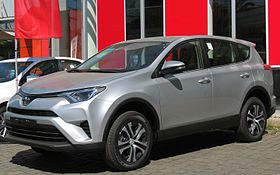
Toyota RAV4 (Chile; facelift)
|
|
| Overview | |
| Manufacturer | Toyota |
| Production | 1994–present |
| Body and chassis | |
| Class | Compact crossover SUV (5-door) Mini SUV (3-door) |
| Layout | Front-engine, front-wheel-drive or four-wheel-drive |
In most markets, the RAV4 is the only compact SUV or crossover available from Toyota. In other markets, it is the crossover counterpart of the Toyota FJ Cruiser. Since the 2006 third generation model, Toyota has offered both short- and long-wheelbase versions of the RAV4. Short-wheelbase versions are sold in Japan and Europe; long-wheelbase versions in Australia and North America. Toyota of Japan also sells the longer-wheelbase version as the Toyota Vanguard at Toyopet Store locations. Japanese versions are sold at two different Toyota Japanese dealerships, called Toyota Corolla Store and Toyota NETZ Store.
First generation (XA10; 1994–2000)
| First generation (XA10) | |
|---|---|

Pre-facelift Toyota RAV4 5-door (Australia)
|
|
| Overview | |
| Production | 1994–2000 (RAV4) 1997–2003 (RAV4 EV) |
| Model years | 1995–2000 |
| Assembly | Japan: Toyota, Aichi and Tahara, Aichi |
| Body and chassis | |
| Body style |
|
| Powertrain | |
| Engine |
|
| Transmission |
|
| Dimensions | |
| Wheelbase |
|
| Length |
|
| Width | 1,695 mm (66.7 in) |
| Height |
|
The first generation RAV4, known as the XA10 series was constructed on a unique platform that shared Carina and Corolla elements. It launched in Japan in May 1994.
The XA10 series was offered in both three- and five-door versions. In the US, a 2.0-liter straight-four producing 89 kW (119 hp; 121 PS) was offered. Both front-wheel drive and all-wheel drive were available, and the RAV4 could be had with either a five-speed manual or four-speed automatic transmission. It was named the 1997 Automobile of the Year by Automobile Magazine. In 1997 for the 1998 model year, the RAV4 was slightly restyled on the front and rear fascias, and a soft top three-door was made available. Power was increased slightly to 95 kW (127 hp; 129 PS). In June 1999, the two-door hardtop was dropped from the American lineup, leaving the five-door and soft top models. In Japan, the 2.0-liter 3S-GE BEAMS engine with 132 kW (177 hp; 179 PS) was also available.
RAV4 EV
The RAV4 EV is a plug-in, all-electric variant of the RAV4. Produced from 1997 to 2003 for fleet lease, this "zero emission" model was only offered for public sale for seven months in 2002, in very small quantities in California. Powered by an advanced Nickel-metal hydride (NiMH) battery pack capable of storing 27 kWh, the RAV4 EV can go up to 193 kilometres (120 mi) between charges, and came with a 97,000-kilometre (60,000 mi) battery warranty. A total of 1,484 units were leased and/or sold in California, and as of mid-2012, there were almost 500 units still in use.
Second generation (XA20; 2000–2005)
| Second generation (XA20) | |
|---|---|
 |
|
| Overview | |
| Production | May 2000–November 2005 |
| Model years | 2001–2005 |
| Assembly |
|
| Designer | Kevin Hunter (5-door: 1997) Yasuhide Hosoda (3-door & 5-door: 1997) |
| Body and chassis | |
| Body style |
|
| Powertrain | |
| Engine |
|
| Transmission |
|
| Dimensions | |
| Wheelbase |
|
| Length |
|
| Width | 1,735 mm (68.3 in) |
| Height | 1,650–1,680 mm (65.0–66.1 in) |
| Curb weight | 1,150 kg (2,535 lb) |
The second generation, XA20 series RAV4 went on sale in July 2000. Like the previous model, the XA20 was available in three- and five-door configurations and was constructed on a platform that shared Carina and Corolla elements. Development began in 1995, with a design freeze in the first half of 1998. Styling was done at Calty Design Research Incorporated (also simply known as Calty) by Yasuhide Hosoda and Kevin Hunter from 1996 to 1997.
The second generation RAV4 was originally offered in a number of trim levels in the UK: NV was front-wheel drive, while NRG, GX, and VX were permanent four-wheel drive with differing levels of equipment. Although the RAV4 was available as a three-door in Europe, Asia and Australia, the American model was now only available in a five-door configuration. A 1.8-liter inline-four engine (only with 2WD) producing 92 kW (123 hp; 125 PS), 2.0-liter inline-four engine producing 110 kW (150 hp; 150 PS), and a D-4D diesel engine were available. Some RAV4s came with anti-lock braking system, electronic stability control, air conditioning, a height-adjustable driver's seat, cruise control, a six-speaker CD stereo and power windows, mirrors and seats. A sport package added a mesh grille, bonnet scoop, colour-keyed door handles, a roof rack, silver sport pedals, heated mirrors, gray-painted bumpers and fender flares, and sport fabric seats. Other options included alloy wheels, heated seats, a sunroof and keyless entry. 16-inch wheels were standard; larger tires were available on all-wheel-drive models.
In Australia, the RAV4 came in base Edge and upmarket Cruiser models in both three- and five-door configurations. The main differentiation between the two models was in appearance. Edge models came with unpainted grey bumpers and side cladding, mirrors, and door handles, and featured steel rims. Cruiser models gained body-coloured (painted) bumpers and moldings, mirrors, and door handles, alloy wheels, and ABS brakes. All models came equipped with a brand-new 2.0-liter four-cylinder engine featuring VVT (variable valve timing), resulting in improved power and torque, as well as fuel consumption. Permanent all-wheel-drive was a feature. Options were ABS brakes (on the Edge), and air conditioning (on all models). The second generation RAV4 enjoyed success in Australia, where it became the best-selling SUV in the country in 2001, overtaking its rival, the Honda CR-V, for the first time.
In late 2003, the 2004 model RAV4 was given a styling update, improved equipment, and, in certain markets, a new engine. In the United States the safety structure was improved and Vehicle Stability Control made standard. The RAV4's 2.0-liter engine was upgraded with a new 2.4-liter engine, producing 120 kW (160 hp; 160 PS) and 220 N·m (162 lb·ft). Electric air conditioning also became available in Europe.
In Australia, for the facelift, the base Edge was renamed CV, and gained standard air conditioning (previously an option). The CV also received painted bumpers, which came in either silver or body-coloured shades, depending on the body colour. In addition, the model range was given a subtle facelift, consisting largely of a new front bumper with circular fog lights and white turn signals instead of the older orange lights. In 2005, a new "CV Sport" model was added to the range in Australia, which included a non-functional bonnet scoop, giving the RAV4 a more aggressive appearance. The CV Sport model was short-lived, lasting only a year, and was introduced primarily to stimulate sales until the new model arrived in early 2006.
Notably, the second-generation RAV4 had the highest proportion of female drivers among all makes and models in the United States with the possible exception of the Volkswagen New Beetle, according to 2003–2004 registration and survey data.
Gallery
-
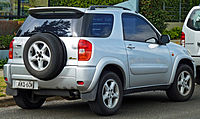
Pre-facelift Toyota RAV4 Cruiser hardtop (Australia)
-
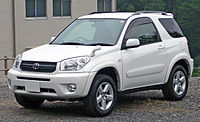
Facelift Toyota RAV4 hardtop (Japan)
-
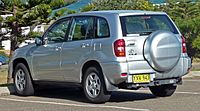
Facelift Toyota RAV4 CV (Australia)
Third generation (XA30; 2005–2012)
| Third generation (XA30) | |
|---|---|
 |
|
| Overview | |
| Also called | Toyota Vanguard (Japan, LWB) |
| Production |
|
| Model years |
|
| Assembly |
|
| Body and chassis | |
| Body style | 5-door wagon |
| Platform | Toyota New MC platform |
| Powertrain | |
| Engine |
|
| Transmission |
|
| Dimensions | |
| Wheelbase | 2,560–2,660 mm (100.8–104.7 in) |
| Length | 4,395–4,620 mm (173.0–181.9 in) |
| Width | 1,815–1,855 mm (71.5–73.0 in) |
| Height | 1,685–1,755 mm (66.3–69.1 in) |
| Chronology | |
| Successor | Toyota C-HR (Japan) Toyota Harrier (XU60) (Vanguard) |


The Toyota RAV4 was redesigned for the 2006 model year, using an all-new platform and was first unveiled at the 2005 Frankfurt Motor Show. The new RAV4 uses an Electric Power Steering (EPS) system.
The third generation RAV4 is offered in two versions: a short- or a long-wheelbase model. The short-wheelbase model is sold only in Japan, Europe and New Zealand (diesel only in NZ), with the long-wheelbase RAV4 sold in Australia, New Zealand and North America. Since 2007, the extended-length RAV4 is also sold alongside its shorter counterpart in Japan as the Toyota Vanguard, albeit with a revised front-end body work incorporating a revised grille, bumper, bonnet and headlamps.
Japanese models went on sale in 2005 at Toyota NETZ dealers. The 3-door was dropped in the beginning of 2007, leaving Toyota without a mini SUV until the 2009 Toyota Urban Cruiser, which is sold in Europe, North America (as the Scion xD) and Japan (as the Toyota ist). The XA30 series RAV4 was sold in Japan until July 2016, where the XA40 is not to be offered and was replaced there by the Toyota C-HR. Toyota discontinued the Vanguard in November 2013 in favour of the redesigned Harrier XU60.
It is also the first generation of RAV4 to be offered in regular (for Asian and European markets, dropping the spare wheel from the rear) and extended (for North American and Australian markets) versions. The extended-length RAV4 is larger by 21% in interior volume from the last generation and now has an available third-row seat for two small children (North America and Japan only). The RAV4 can still be had in either front-wheel-drive or all-wheel-drive in North America and Japan; however most countries only sell the all-wheel-drive version.
In 2008 (for the 2009 model year) RAV4 was given a mid-cycle refresh in some markets, featuring a number of changes, including an all-new 4-cylinder engine, and a redesigned front end and tweaked rear end. The Limited model gets a different front grille and bumper cover from other models. The Sport model features a bigger spoiler and red badging along with an option on the V6 model to have a rear door without the externally mounted spare tire (run-flat tires are used on this model). New features/options include turn signals integrated into the side mirrors, backup camera (with monitor built into rear-view mirror), satellite navigation, smart keyless entry, a push button starter, a multi-function instrument cluster display, etc. Much of the interior remains the same. In 2009, it was also the first time for the Canadian market to have a 2WD model sold in Canada.
In 2011 (for the 2012 model year) the RAV4 underwent another, light, facelift.
The vehicles were built in Toyota's Tahara, Aichi assembly plant, and under contract by Toyota Industries in its Nagakusa, Obu, Aichi plant. Beginning in November 2008, vehicles for the North American market were built in the Toyota Motor Manufacturing Canada Inc., Second Plant. Beginning in March 2009, Chinese models began production by Tianjin FAW Toyota Motor Co. Ltd. in a joint-venture plant in Tianjin, China.
In 2015, the XA30 series RAV4 was awarded the WheelsTV pre-owned vehicle of the year title.
- Japan
Model ranges include X, G, and Sport, replacing RAV4 L and RAV4 J. The X and G can be ordered with either front-wheel-drive or AWD. The Sport model with over fenders is AWD only. The extended-length RAV4 is sold in Japan as the Toyota Vanguard, released on August 30, 2007. It is sold in five- and seven-passenger versions and slots between the regular RAV4 and Kluger. As it is often the case in Japan-only vehicles, the Vanguard comes loaded with high-tech gadgets, including steering-assisted stability control, keyless entry and satellite navigation. The Toyota Vanguard was facelifted in 2010.
- Australia
In Australia, the RAV4 is sold in four-cylinder base CV, Cruiser, Cruiser L and the limited edition "Altitude" trim levels, and CV6, SX6, and ZR6 are 6-cylinder variants.
- Malaysia
In Malaysia, only the 2.0-liter automatic variant is available, in a single trim level. This model uses the 1AZ-FE four-cylinder, inline 16-valve engine with DOHC and VVT-i. The output for the 2.0-liter RAV4 in Malaysia is at 112 kW (150 hp; 152 PS) at 6,000 rpm with a torque of 194 N·m (143 lb·ft) at 4,000 rpm.
- Middle East
In the Middle East, the RAV4 is available with a 2.4-liter engine. Most markets, including the United Arab Emirates (UAE) and Kingdom of Saudi Arabia (KSA), get the all-wheel-drive model with an automatic gearbox, but KSA additionally gets a two-wheel-drive model as well, the base one with a manual gearbox.
- North America
North American models include choices of 2.4-litre 2AZ-FE inline-four or 3.5-liter 2GR-FE V6 engine. The V6 model has 201 kW (270 hp; 273 PS). In model year 2009, a slightly larger 133 kW (178 hp; 181 PS) 2.5-liter 2AR-FE inline-four replaced the previous 124 kW (166 hp; 169 PS) 2.4-liter engine. Either four-cylinder engine came equipped with a four-speed automatic transmission. The North American RAV4 with 3.5-liter 2GR-FE V6 engine is fitted with a five-speed automatic transmission. The 2GR engine was later introduced into the Australian market RAV4 in 2007. All US models feature Toyota's Star Safety System which includes Vehicle Stability Control. The new RAV4 topped Toyota SUV sales in the United States for the first time.
No manual transmission or diesel engines are available on North American models.
Facelifted for the 2009 model year, North American models include the choice of a new 2AR-FE inline-four or 2GR-FE V6 engine.
- Mexico
The RAV4 was first introduced in 2004; and was only available in two trim levels: Base and L. This was already an outgoing generation but still sold pretty well and both came in 2WD only and both models had, as standard equipment 16-inch alloy wheels and a roof rack. The new generation RAV4, which is the current model, had more features as standard equipment. Base and Limited trims continue to be available, but on the Limited trim 4WD became an option and the Base model now added 17-inch steel wheels but the roof rack was still standard in both trims. For the refresh of 2009 the roof rack in the Base model was eliminated as standard equipment and the Sport trim was added to the line-up. Up to 2008MY all RAV4s in Mexico had four-cylinder engines but for 2009 the Sport model became available with the V6 engine, although the four-cylinder engine was still available. The Limited trim was only available with the V6 engine and 4WD traction. For 2010, the RAV4 in Mexico has been simplified again to two trims but now the Limited trim was dropped and consequently killed the 4WD option, while the Base and Sport trims remained unchanged from 2009. The RAV4 in Mexico has experienced good acceptance since its introduction.
Gallery
-

Facelift Toyota RAV4 Limited (US)
-

Facelift Toyota RAV4 Altitude (Australia)
-

Facelift Toyota RAV4 (Japan)
-
Toyota Vanguard
-

Interior
-
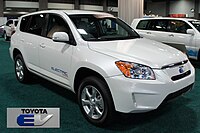
Toyota RAV4 EV (US)
Body styles
| Chassis codes (DBA-A) | ACA31W | ACA36W | ACA33L | ACA37L | GSA30 | GSA35 | ALA30 | ALA31 | ALA36 | ZSA30 | ZSA35 |
|---|---|---|---|---|---|---|---|---|---|---|---|
| Drive | 4WD | FWD | 4WD | FWD | FWD | 4WD | 4WD | 4WD | FWD | FWD | 4WD |
| Engine (Japan) | 2AZ-FE | 2AZ-FE | - | - | - | - | - | - | - | - | - |
| Engine (China) | - | - | 2AZ-FE | 1AZ-FE | - | - | - | - | - | - | - |
| Engine (Europe) | - | - | - | - | 2GR-FE | 2GR-FE | - | 2AD-FTV | 2AD-FTV | 3ZR-FAE | 3ZR-FAE |
Engines
| Code | Years | Type/code | Power, torque@rpm |
|---|---|---|---|
| 1AZ-FE (2.0 VVT-i) | 2005–2012 | 1.998 L (121.9 cu in) (86.0×86.0mm) I4 | 112 kW (150 hp; 152 PS) @ 6,000 rpm, 194 N·m (143 lb·ft) @ 4,000 rpm |
| 1AZ-FE (2.0 VVT-i) | 2007MY-2008MY (UK) | 1.998 L (121.9 cu in) (86.0×86.0mm) I4 | 112 kW (150 hp; 152 PS) @ 6,000 rpm, 194 N·m (143 lb·ft) @ 4,000 rpm |
| 2AZ-FE | 2005–2012 | 2.362 L (144.1 cu in) (88.5×96.0mm) I4 | 132 kW (177 hp; 179 PS) @ 6,300 rpm, 224 N·m (165 lb·ft) @ 4,000 rpm |
| 2AR-FE | 2008–present | 2.494 L (152.2 cu in) I4 | 136 kW (182 hp; 185 PS) @ 6,300 rpm, 233 N·m (172 lbf·ft) @ 4,000 rpm |
| 2GR-FE | 2005–2012 | 3.456 L (210.9 cu in) (94.0×83.0mm) V6 | 201 kW (270 hp; 273 PS) @ 6,200 rpm, 333 N·m (246 lb·ft) @ 4,700 rpm |
| 3ZR-FAE (2.0 Valvematic) | 2008–2012 | 1.987 L (121.3 cu in) (80.5×97.6mm) I4 | 116 kW (156 hp; 158 PS) @ 6,200 rpm, 198 N·m (146 lbf·ft) @ 4,400 rpm |
| 2.0 D-4D | 2005-2006MY | 1.995 L (121.7 cu in) (82.2×94.0mm) I4 | 85 kW (114 hp; 116 PS) @ 4,000 rpm, 250 N·m (184 lbf·ft) @ 1,800–3,000 rpm |
| 2.2 D-4D Diesel | 2007MY-2008MY | 2.231 L (136.1 cu in) (86.0×96.0mm) I4 | 100 kW (134 hp; 136 PS) @ 3,600 rpm, 310 N·m (229 lbf·ft) @ 2,000–2,800 rpm |
| 2.2 D-4D Diesel 180 (UK) | 2007MY | 2.231 L (136.1 cu in) (86.0×96.0mm) I4 | 130 kW (174 hp; 177 PS) @ 3,600 rpm, 400 N·m (295 lbf·ft) @ 2,000–2,600 rpm |
| 2.2 D-4D, 2.2 D-CAT (UK) | 2008–2012 | 2.231 L (136.1 cu in) (86.0×96.0mm) I4 | 110 kW (148 hp; 150 PS) @ 3,600 rpm, 340 N·m (251 lbf·ft) @ 2,000–2,800 rpm |
| 2.2 D-CAT | 2008–2012 | 2.231 L (136.1 cu in) (86.0×96.0mm) I4 | 130 kW (174 hp; 177 PS) @ 3,600 rpm, 400 N·m (295 lbf·ft) @ 2,000–2,800 rpm |
RAV4 EV
Toyota worked together with Tesla Motors to develop the second generation RAV4 EV, and the electric SUV is scheduled for market launch late in the third quarter of 2012. Production will be limited to 2,600 units during the first three years, and sales will be limited to California only, beginning with the San Francisco Bay Area, Los Angeles/Orange County and San Diego.
The second generation RAV4 EV has a 115 kW (154 hp; 156 PS) motor powered by a 41.8kWh lithium ion battery pack, that Toyota expects to deliver a US Environmental Protection Agency rated range of 148 km (92 mi) in standard charge mode and 182 km (113 mi) in extended charge mode, for a combined range of 166 km (103 mi); and a combined fuel economy rating of 3.1 L/100 km (91 mpg‑imp; 76 mpg‑US). The RAV4 EV battery pack and electronic components are similar to those in used in the Tesla Model S sedan launched in June 2012, because Tesla Motors is the manufacturer of the powertrain.
Fourth generation (XA40; 2013–present)
| Fourth generation (XA40) | |
|---|---|
 |
|
| Overview | |
| Production | December 2012–present |
| Model years | 2013–present |
| Assembly |
|
| Designer | Masaki Okue, Akira Kubota and Takuya Watabe (2010) |
| Body and chassis | |
| Body style | 5-door wagon |
| Platform | Toyota New MC platform |
| Powertrain | |
| Engine |
|
| Transmission |
|
| Dimensions | |
| Wheelbase | 2,660 mm (104.7 in) |
| Length | 4,661 mm (183.5 in) |
| Width | 1,845 mm (72.6 in) |
| Height | 1,660–1,705 mm (65.4–67.1 in) |




The fourth generation RAV4 was a complete redesign; it was revealed at the November 2012 Los Angeles Auto Show.
US sales began in early January 2013. In the UK and Australia, the fourth generation RAV4 went on sale in February. Engine choices include a 2.0- and 2.5-litre four-cylinder gasoline, and 2.0- and 2.2-litre turbodiesels. Transmissions include a six-speed manual, Continuously Variable Transmission (CVT), and six-speed automatic.
The RAV4 manufactured in Woodstock, Ontario, Canada has about 50 percent of its parts coming from Japan.
The UK model went on sale in 2013. Early European models include a choice of a 2.0-litre petrol or one of three 2.0-litre diesel engines.
Taiwanese models include a 2.0-litre Dual VVT-i inline four-cylinder engine with 7-Speed Continuously Variable Transmission (Sequential Manual) or 2.5-liter Dual VVT-i inline-four engine with six-speed automatic.
Indonesian models went on sale in early 2015 and first unveiled at the 2014 Indonesia International Motor Show (IIMS) in Jakarta in September, only available in G type. It includes a 2.0-litre Dual VVT-i engine with CVT transmission (with seven-speed manual mode).
The RAV4 no longer uses the V6 from the previous generation—all engine choices are inline four cylinder engines. Also, unlike the dual wheelbase strategy employed by the previous XA30 model, the XA40 is only sold in single wheelbase (corresponding with the LWB XA30). Therefore, as of April 2014, the previous generation in short-wheelbase length is still sold in Japan in lieu of the newer XA40 which is for export only. The Harrier replaces the long-wheelbase model in Japan, previously badged as the Vanguard. This generation RAV4 has a more traditional tailgate that opens upward instead of the side-opening tailgate of the previous generations.
The full hybrid system combines a 2.5-litre Atkinson cycle petrol engine with a powerful electric motor, a 204 cell nickel–metal hydride battery located under the rear seats, a power control unit, and a power split device. RAV4 Hybrids are available in both front and all-wheel drive variants. The all-wheel edition comes equipped with a second, 50 kW high-voltage, rear mounted electric motor that offers increased traction and a 1,750-pound (790 kg) towing capacity. The engine is capable of operating independently from the hybrid system front's electric motor, driving the rear wheels alone.
Facelift
In 2015 for the 2016 model year, Toyota released a facelift for the XA40 series. The facelift debuted with the RAV4 Hybrid shown at the April 2015 New York International Auto Show. The facelift includes redesigned LED front and rear lamps and updated speedometer dials with full color TFT multi information display.
Safety

In the Insurance Institute for Highway Safety (IIHS) evaluations, the 2013 and 2014 model year RAV4 achieved a "good" crashworthiness rating for head restraints and seats, roof strength, side, and moderate overlap front, while achieving a "poor" rating in small overlap front. Modifications were made starting in the 2015 model year which increased the small overlap front rating to "good".
The small overlap test, introduced in 2012 by the IIHS, simulates a frontal collision on 25 percent of the driver's side. Since its adoption, the IIHS has noticed several automakers making non-symmetrical modifications to their vehicles, including the RAV4. Another small overlap test was conducted on a number of vehicles, including a 2015 RAV4, but was conducted on the passenger side instead. The RAV4 fared the worst and would have received a "poor" rating if the IIHS were to provide ratings for passenger-side protection. The crash test's intrusion was 330 millimetres (13 in) further into the vehicle on the passenger's side than on the driver's side and caused the passenger door to open during the crash.
RAV4 Adventure and RAV4 Premium (2013)

The RAV4 Adventure is a concept vehicle that accentuated the car's look to reinforce its off-road capabilities. It included dark red body colour, extended wheel arches, 20-inch alloy wheels and matte painted front and rear bumpers.
The RAV4 Premium is a concept vehicle with Deep Bronze body colour, bumpers in Deep Bronze, chrome-finished spoiler, chrome inserts in the rear bumper, brushed aluminium skid plates, integrated tailpipe at the rear bumper, 20-inch wheels, leather interior upholstery designed by Toyota's Kansei design department, seats with black piping and V-shaped outline, two-tone double stitching and grey and black leather on the instrument panel and door panels.
Both vehicles were unveiled at the March 2013 Geneva Motor Show.
In 2017, for the 2018 model year, a production version of the RAV4 Adventure will be added to the lineup of the RAV4.
| Model | Year(s) | Displacement | Fuel Type | Power | Torque | 0–100 km/h (0–62 mph) | CO2 Emissions |
|---|---|---|---|---|---|---|---|
| 2.0 AWD | 2012– | 1,987 cc (121.3 cu in) | Petrol | 111 kW (149 hp; 151 PS) | 195 N·m (144 ft·lb) | 9.9 s | 167 g/km |
| 2.0 Multidrive AWD | 2012– | 1,987 cc (121.3 cu in) | Petrol | 111 kW (149 hp; 151 PS) | 195 N·m (144 ft·lb) | 10.7 s | 166 g/km |
| 2.5 | 2012– | 2,494 cc (152.2 cu in) | Petrol | 131 kW (176 hp; 178 PS) | 233 N·m (172 ft·lb) | 8.6 s | 169 g/km; 23 city/29 hwy |
| Hybrid | 2015– | 2,494 cc (152.2 cu in) | Petrol/Electric Motor | 145 kW (194 hp; 197 PS) combined | 279 N·m (206 ft·lb) combined | 8.1 s | 115 g/km; 33 city/31 hwy |
| Model | Year(s) | Displacement | Fuel Type | Power | Torque | 0–100 km/h (0–62 mph) | CO2 Emissions |
|---|---|---|---|---|---|---|---|
| 120D 4x2 | 2012– | 1,998 cc (121.9 cu in) | Diesel | 91 kW (122 hp; 124 PS) | 310 N·m (229 ft·lb) | 10.5 s | 127 g/km |
| 120D AWD | 2013– | 1,998 cc (121.9 cu in) | Diesel | 91 kW (122 hp; 124 PS) | 310 N·m (229 ft·lb) | 13.6 s | 136 g/km |
| 150D AWD | 2012– | 2,231 cc (136.1 cu in) | Diesel | 110 kW (148 hp; 150 PS) | 340 N·m (251 ft·lb) | 9.6 s | 147 g/km |
| 150D Autodrive AWD | 2012– | 2,231 cc (136.1 cu in) | Diesel | 110 kW (148 hp; 150 PS) | 340 N·m (251 ft·lb) | 10.0 s | 173 g/km |
Sales
| Calendar Year | U.S. | Canada |
|---|---|---|
| 1996 | 56,709 | ? |
| 1997 | 67,489 | ? |
| 1998 | 64,990 | ? |
| 1999 | 57,138 | ? |
| 2000 | 53,777 | ? |
| 2001 | 86,368 | ? |
| 2002 | 86,601 | ? |
| 2003 | 73,204 | ? |
| 2004 | 70,314 | ? |
| 2005 | 70,518 | ? |
| 2006 | 152,047 | ? |
| 2007 | 172,752 | ? |
| 2008 | 137,020 | 20,522 |
| 2009 | 149,088 | 25,784 |
| 2010 | 170,877 | 22,810 |
| 2011 | 132,237 | 21,550 |
| 2012 | 171,877 | 25,942 |
| 2013 | 218,249 | 33,156 |
| 2014 | 267,698 | 36,639 |
| 2015 | 315,412 (inc. 1,507 hybrids) | 42,246 |
| 2016 | 352,154 (inc. 45,070 hybrids) |









